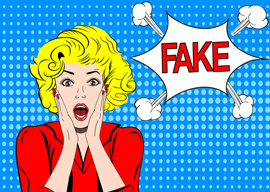
August 09, 2018

Source: Bigstock
No, Enemy of the People is an Ibsen play. It does have a craven newspaper editor as one of its principal characters, but when the phrase “enemy of the people” is used, it’s used to describe the play’s hero, so it’s used ironically—once again, we’re getting über-meta now—to celebrate the minority that would rise up against the self-righteous majority. Therefore, “enemy of the people” is sort of what the press is supposed to be doing. (This is making my head hurt.)
The fact that Trump recently used “enemy of the people” to describe the media—and I don’t care what tweet it was and I’m too lazy to look it up—indicates once again that the words “Fake News” on a shirt are assumed to be (a) pro-Trump, (b) anti-media, and (c) non-ironic.
By the way, the “Alternative Facts” T-shirt is still on sale at the Newseum gift shop. I’m going to guess that it survived because it’s a nostalgia item, bringing up distant memories of the falsified body count at the presidential inauguration, our beloved Sean Spicer, and Kellyanne Conway’s first foray into Trumpspeak.
At any rate, the reason the term “fake news” apparently annoys so many members of the press gallery—which is why Trump continues to use it—is that it undermines trust in news organizations and lumps them in with bogus boiler-room operations in Macedonia that churn out fake websites. This idea, the journalists imply, is a threat to our elections, to our democracy, and to our way of life. And the reason they believe this is that they believe the consumer of news is stupid. They believe the average voter lacks the ability to distinguish between fact and malicious gossip. And they pretend naively that malicious gossip was invented by the internet.
As I’ve pointed out many times—maybe one of these years someone will believe me—the internet didn’t create anything. The internet is a tool. It just makes thing easier to access—including malicious gossip. But the malicious gossip has always been there.
Maybe everyone would calm down if, instead of using the term “fake news,” we would go back to the older term: “yellow journalism.”
Yellow journalism is what journalists use to describe sensationalist reporting, crude reporting, headlines designed only to make people buy the paper, and, in many cases, details and quotes that are invented by the reporter to embellish a story that would otherwise be boring.
Yellow journalism is celebrated in the great Ben Hecht–Charles MacArthur comedy The Front Page, which debuted on Broadway in 1928, but it’s actually older than that.
Yellow journalism was invented by Joseph Pulitzer, publisher of the St. Louis Post-Dispatch and The New York World, in the 19th century.
Yellow journalism is given credit for starting the Spanish-American War, thanks to the aforesaid New York World and its bitter circulation battle with William Randolph Hearst’s New York Journal.
So today the inventor of “fake news,” Joseph Pulitzer, is honored once a year by every newspaper in America, every book publisher in America, and every playwright in America, because they’re all attempting to win the award named after him—the Pulitzer Prize.
Whoops.
Comments on this article can be sent to the .(JavaScript must be enabled to view this email address) and must be accompanied by your full name, city and state. By sending us your comment you are agreeing to have it appear on Taki’s Magazine.